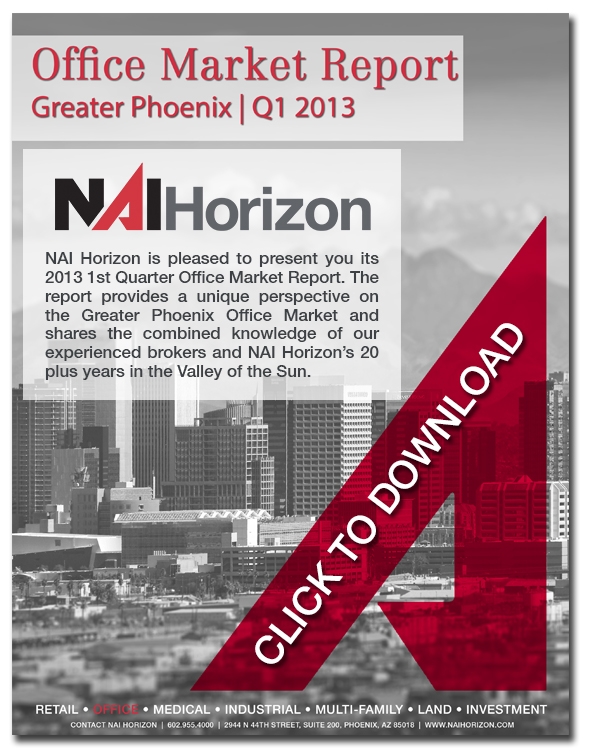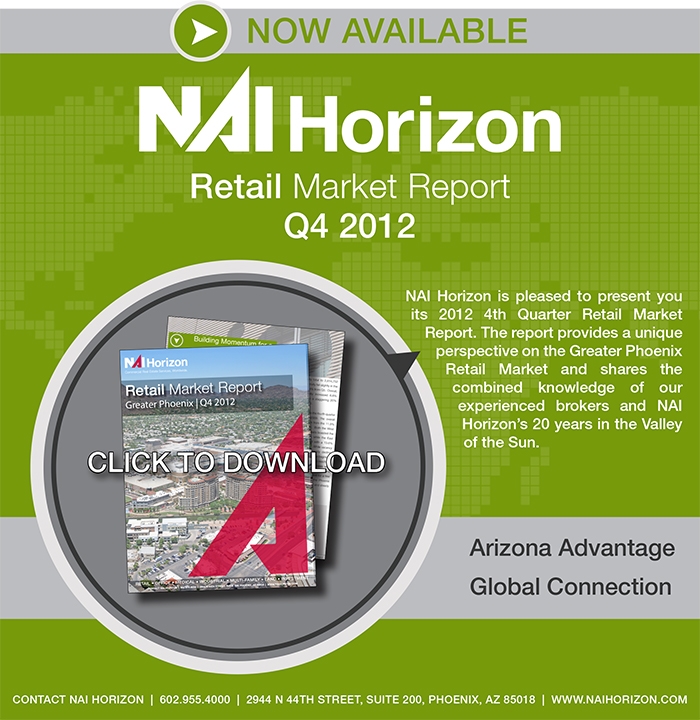The Phoenix Valley office market continues to trek up the long road to pre-recession levels. With vacancy continuing its slow but steady decline, and absorption continuing to post positive numbers, the sector seems to have stabilized from its low point. The previous year, 2012, boasted the highest leasing activity in several years and hopes are high that the trend will continue well into 2013. The market is beginning to see a noticeable increase in large users, including the announcement by State Farm Insurance of a 1 million SF headquarters campus to be built on the south side of Tempe Town Lake, expected to bring over 5,000 employees. In addition, Governor Brewer announced several promising Valley expansions that could result in over 2,000 new jobs in the next 3 years; 600 new jobs coming to Scottsdale through ZocDoc, 1,000 high tech jobs with the General Motors IT Innovation Center in Chandler, over 300 new jobs in Glendale with Zytech Building Systems, and approximately 250 mortgage professional jobs in Tempe with Union Bank. As the Valley continues to be a hot spot for companies looking to expand, the market should expect to see exponential improvements.
Overall vacancy fell slightly this quarter to 20.4% from its 20.6% rate at the end of 2012, down substantially from Q1 2012 when the vacancy rate was 22.4%. Class A office vacancy continued to decline to a rate of 20%, a significant decrease year over year; Q1 2012 posted a vacancy rate of 23.8%. Class B spaces are also moving in a positive direction, resulting in a vacancy rate of 21%, down from 21.3% at the end of 2012, and down considerably from Q1 2012 at 22.6%. Class C continues to remain stagnant, with vacancy rates increasing slightly to 17.2% this quarter, up from 17.1% from the end of 2012, and rising from the 16.4% rate seen at the beginning of 2012.
While absorption figures remained positive for the first quarter of 2013, total net absorption is down significantly from the impressive Q4 of 2012. With 195,034 SF of net space absorbed this quarter, 226,281SF consisted of Class B office properties, while Class C properties continued to post negative numbers with -50,777 SF of net absorbed space. This trend remains visible as tenants are taking advantage of the market to leave lower grade properties while rental rates remain low.
Despite positive news in vacancy, leasing activity lagged this quarter with 1.6 million SF leased so far this year, the lowest first quarter seen in 5 years. This number is down since the end of 2012, when over 2 million SF of office space was leased in the final quarter. As new large users begin to take advantage of the currently low rental rates it is anticipated that the next several quarters will see an uptick in activity due to these newly signed long-term leases.
Rental rates fell slightly this quarter after three quarters with relatively no change. Q1 posted an average rental rate of $19.68 PSF, compared to the $20.04 PSF exhibited for most of 2012. Class A space rental rates remained flat at $23.16 PSF, while Class B fell slightly to $18.48 PSF after stabilizing at $18.96 PSF over the last three quarters. Class C space fell to $14.01 PSF after three quarters at $14.52 PSF.
It is anticipated that the progress of 2012 will continue into 2013; with absorption stabilizing and vacancy rates continuing to decline, rental rates should begin to improve as the market shows signs of recovery. While a fully sustained recovery in the office sector is still years away, economic conditions in the Phoenix area are continuing to improve at a faster pace than most metro areas in the US.


